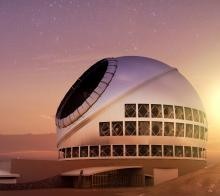TMT Hearing: Does the Project Meet the Eight Criteria?
The contested case hearing for the state Board of Land and Natural Resources Conservation District Use Application (CDUA) continued on Jan. 23, 24, 25 and 26 as petitioners opposing the proposed TMT International Observatory’s (TIO) Thirty Meter Telescope (TMT) project called their witnesses to the stand in Hilo.
The reason for this contested case hearing between proponent parties and petitioners of the TMT is to deem whether or not the project is deserving of the necessary Conservation District Use Permit it needs in order to proceed.
Among other issues, such as spirituality and sacredness of the mountain, petitioners have been stressing through their witnesses that the project does not meet Hawai‘i Administrative Rules section 13-5. In it, there are eight criteria the Department of Land and Natural Resources must evaluate before allowing construction on a conservation district, such as Mauna Kea.
Those eight criteria include:
- The proposed land use is consistent with the purpose of land conservation district;
- The proposed land use is consistent with the objectives of the subzone of the land on which the use will occur;
- The proposed land use complies with provisions and guidelines contained in Chapter 205A, HRS, entitled “Coastal Zone Management,” where applicable;
- The proposed land use will not cause substantial adverse impact to existing natural resources within the surrounding area, community or region;
- The proposed land use, including buildings, structures and facilities, shall be compatible with the locality and surrounding areas, appropriate to the physical conditions and capabilities of the specific parcel or parcels;
- The existing physical and environmental aspects of the land, such as natural beauty and open space characteristics, will be preserved or improved upon, whichever is applicable;
- Subdivision of land will not be utilized to increase the intensity of land uses in the conservation district; and
- The proposed land use will not be materially detrimental to the public health, safety and welfare.
Witness Dr. Maile Taualiʻi, who holds a Ph.D. in health services and is considered a leading expert in health for Native Hawaiians, conducted extensive research on the impacts the telescope would have on the public health.
She found that the potential desecration of Mauna Kea, which would then diminish cultural and traditional practices, would harm Native Hawaiians mentally, emotionally, physically and spiritually.
“When desecration occurs,” Taualiʻi said, “the people are impacted and are not able to follow their beliefs. This, in turn, affects their cultural identity, and causes the link between the sacred space and the people to become disrupted. When this link is strained or broken, health is affected.”
Dr. Peter Mills, a full professor of anthropology at UH Hilo, said that when reviewing TMT’s CDUA, it was missing the broad scope of assessing the adverse effects of building a TMT.
In their CDUA, the adverse effects were only based on cultural practitioners physically on or near the mountain, but failed to mention indirect practitioners and customary and traditional practices off the mountain, which is fundamental in cultural impact assessments. Mills used the example of a cultural practitioner waking up every morning in Waimea to see a thirty-meter telescope from their home, and said that should be considered as an adverse effect.
Michael Kumukauoha Lee, a papakilohoku (star priest), shared the moʻolelo (story) of how his family is connected to the proposed TMT site through two pahoehoe caves that “weave a path to the sea,” he said.
The TMT “intentionally wounds my family’s historical presence that is consistent,” Lee said, “and this is cumulative injury.”
Asked if building a TMT would block the view plane of Haleakalā, Lee answered that it would be like building a concrete high-rise in front of the Wailing Wall or Mount Fuji.
Petitioner Harry Fergerstrom ended his redirection of Lee by going through each of the eight criteria to clarify if Lee either agreed or disagreed that the criteria were met.
Lee said the project did not meet any of the eight criteria.
Again, according to state administrative rules, if the project does not meet the eight criteria outlined above, it should not receive a Conservation District Use Permit.
The BLNR contested case hearing is scheduled to continue next week and into February in the Grand Naniloa Hotel Crown Room in Hilo from 9 a.m. to 4:30 p.m.
Sponsored Content
Comments









